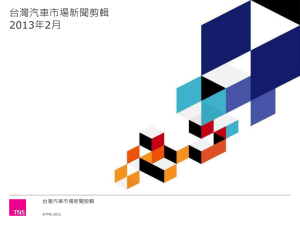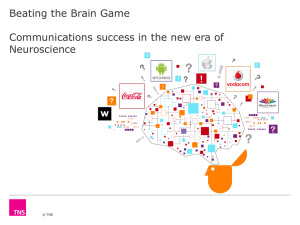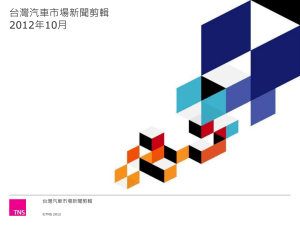SoNA analysis
advertisement
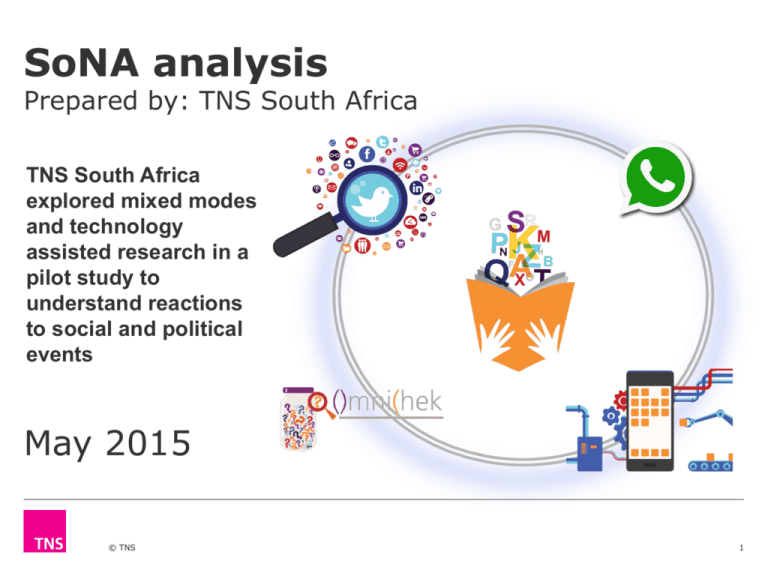
SoNA analysis Prepared by: TNS South Africa TNS South Africa explored mixed modes and technology assisted research in a pilot study to understand reactions to social and political events May 2015 © TNS 1 Context and approach © TNS Context to why this study was conducted In February this year, President Jacob Zuma delivered his Sate of the Nation (SoNA) address, a few days after President Barak Obama. The media helped to create interest in the build-up to the annual South African event based on political party interactions around pertinent issues that should be addressed. TNS South Africa saw the opportunity to test the hypothesis that large and important events such as this will create conversations that may for some time challenge or influence thinking and perceptions. A mixed methodology was designed to test this by incorporating social media, a virtual qualitative discussion group, a mobile survey and a traditional face-to-face survey. The surveys were positioned strategically to measure perceptions during, a few days after and two weeks after the event. Social media analysis indicated that the voluntary engagement led to short topical interactions that did not evolve into much discussion. The following slide indicates the short space of intense discussion that fell away as quickly as it had started. We expected the event to create a longer “tail” of conversations around specific themes, but this was not the case. From the WhatsApp qualitative group we found very rich and detailed descriptions of feelings and perceptions during the course of the event. We were able to build a detailed map of the reactions as it unfolded. Feedback from the mobile survey extracted similar emotions albeit toned down and a little more rationalised. The survey rekindled some of the sentiment but it was not as spontaneous. The last survey, the Omnibus, two weeks later, showed the influence of time; rationalised and toned down responses to well known concerns. Using different methodologies to measure the impact or influence of social and political events will be an important consideration depending on what the aim of the survey is. We thought of sharing this with you as part of new and innovative research thinking. © TNS 3 Context and approach 1. Social Media Analysis 2. WhatsApp Group 3. Mobile Survey 4. Omnibus Survey © TNS 4 Social media analysis © TNS The build-up to SoNA 1. Social Media Analysis The public were very vocal about what they wanted the President to speak about. However, there was also a general sentiment that SoNA shouldn't take place until the Nkandla money was repaid. Will he address youth unemployment? How disruptive will the EFF be? Will he pay back the money? What will be said about the youth wage subsidy? Will he be articulate? Source: Twitter (20 January to 27 February 2015) © TNS 6 1. Social Media Analysis As expected, the volume of tweets relating to SoNA spiked on the day of the address, causing SA’s first official Twitter Storm 50000 Popular hashtags used: # #PayBackTheMoney # #SoNA2015 # # # ANC nkandla zuma bringbackthesignal EFF Most retweeted tweet: @GarethCliff: #PayBackTheMoney 45000 40000 35000 30000 25000 20000 15000 10000 5000 0 Favourite tweet: #SoNA2015 The EFF is not tearing our country apart Mr Buthelezi, our President is. #PayBackTheMoney Source: Twitter (20 January to 27 February 2015) © TNS 7 Top communities Community name 1. Social Media Analysis These communities make up: 30% of all users 41% of all tweets % of users % of all tweets EFF 6.6 11.9 DA 3.7 5.8 AfriForum 3.1 4.3 EWN and Mmusi Maimane 2.8 3.4 ANC/Government 2.5 2.7 SABC News 2.3 3.5 Public influencers 1.9 2.4 eNCAnews 1.6 1.9 SA and African news agencies 1.5 1.8 Source: Twitter (20 January to 27 February 2015) © TNS 8 8 Community 1 – EFF 1. Social Media Analysis EFF community 6.6% of all users & 11.9% of tweets Within the community, conversations are dominated by official party voices There is also strong support from public influencers such as @sentleste Source: Twitter (20 January to 27 February 2015) © TNS 9 Community 2 – DA 1. Social Media Analysis DA community 3.7% of users, 5.8% of tweets – Approximately half the size of the EFF community – The DA News and Helen Zille dominate the community – Mmusi Maimane has a strong presence which further develops after SoNA Source: Twitter (20 January to 27 February 2015) © TNS 10 1. Social Media Why no tail…? Analysis For an event that created such high volumes of engagement on the day, there was a surprisingly small conversation tail Emotional hype, quick succession of topics © TNS Event structured and focussed Loss of interest in political sentiment 11 WhatsApp group © TNS 2. WhatsApp The approach Group TNS conducted a qualitative mobile think tank with South African citizens, tapping into their thoughts and feelings inthe-moment and post-SoNA Mix of age, race and gender Mix of political party supporters 12 12 February 2015 (day of SoNA) – 13 February A mobile community group was set up and asked to participate in running commentary Gauteng Cape Town © TNS DBN 13 Emotional journey during SoNA 2. WhatsApp Group The overall resulting sentiment was that SoNA 2015 was a rehash of SoNA 2014, with very little hope for change… “recycled”, “reshuffled”, “just a tweak in numbers”, and “a story told before”. © TNS 14 2. WhatsApp Key themes that emerged Group We pick ourselves up • We love our country • No point running away • Improvement through new leadership Loss of confidence in the Speaker • Signal jamming • EFF disruptions • DA walkout Negative implications for South Africa • Concern over global perceptions • Politicians fulfilling their own agenda • Fear for the future of democracy A very interesting sentiment journey © TNS 15 Mobile and Omnibus Surveys © TNS Achieved national coverage 3. Mobile Survey 4. Omnibus Survey TNS Omnibus Feb 2015 Survey 27 Feb - 18 Mar 2015 Base: 2 000 TNS Mobile SoNA Survey 13 - 14 February 2015 Base: 1 100 © TNS 17 © TNS 4.4% 3.5% 3.5% Failed to address issues / should have answered the ques(ons Pay back the money / Zuma Speaker should not have allowed that / No order in the house Parliament not working / Speech did not address the problems top / All for themselves all right 3.9% It is all corrupt / Corrup(on at the 4.3% SoNA was good / All fine / It was I did not follow / Not interested party poli(cs is about 5.5% Democracy at work / This is what DisrespecDul / Do not listen to one another 6.4% No respect for one another / par(es behave like that This is just party poliHcs / Poli(cal ANC did nothing wrong / allow President to deliver his speech 8.5% Respect the President and ANC / Chaos Out of control / Out of order / us / Hooligans It was a circus / Made a mockery of Barbaric / Disgraceful Embarrassing / Disgus(ng / Rekindle sentiment using mobile survey after a few days of time to think… 3. Mobile Survey 15.5% 10.7% 8.5% 3.4% 3.2% 18 4. Omnibus Survey Comparing the results… The electricity/Eskom situation 49% Addressing unemployment 30% Improving service delivery 30% Addressing corruption Growing the SA economy The poor state of education Violent crime Reducing government wastage Removing incompetent government employees Nkandla Addressing xenophobia 21% 27% 20% 13% 15% 16% 21% 12% 13% 10% 14% 8% 31% 7% 11% The poor state of the health 6% 10% system © TNS 28% 24% 16% 29% Key topics highlighted in Omnibus survey 19 Learnings and Summary © TNS Why the different results between the surveys? Daniel Kahneman’s dichotomy between the two modes of thought illustrate the differences between the Mobile Survey and the Omnibus survey very well: "System 1" is fast, instinctive and emotional "System 2" is slower, more deliberative, and more logical. . Mobile Survey “System 1” thinking Omnibus Survey “System 2” thinking On a mobile device Interview led survey discussion Instant reaction Spoke to friends and family Shortly after event A number of days after the event Little interference from outside world Have heard media reports Learnings and summary 1. Social Media Analysis: In-the-moment and unprompted. Opinions expressed on a large scale, but no influence over conversation. Often high emotional intensity 2. WhatsApp Group: Stimulusdriven platform, yields very rich detail. Ideal for short, focused engagement 3. Mobile Survey: Highly flexible. Interviewing starts immediately, with short turnaround. Ideal to allow some time to reflect over event. Good sentiment analysis 4. Omnibus Survey: Rationalised perception, media influence a reality. Longer questionnaire can be administered Not all methodologies are created equal Optimising through methodology integration © TNS 22 Thank you! For more information, please contact: Jan Wegelin Senior Team Leader Political and Social Research Johannesburg, South Africa o +27 11 778 7500 d +27 11 778 7730 e Jan.Wegelin@tnsglobal.com © TNS

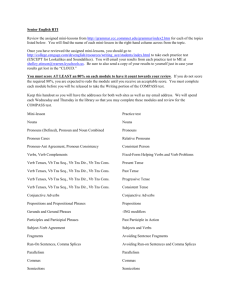

![(TNS Foundation)[1]](http://s3.studylib.net/store/data/007346973_1-c15d24f994805b770e00d79c8993f9db-300x300.png)
